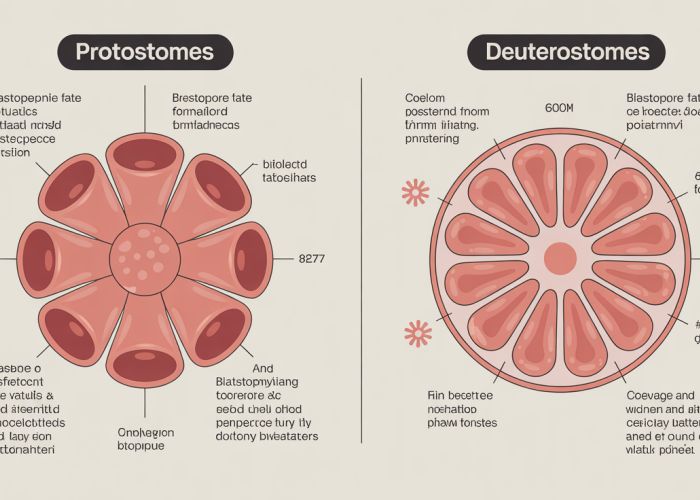The realm of embryonic development holds profound clues to understanding the diversity of animal life. Spiral cleavage, a distinctive pattern of cell division, characterizes many protostomes. Understanding blastopore fate is crucial because protostomes develop through this initial opening forming the mouth. Researchers at the Woods Hole Oceanographic Institution are actively studying these processes to shed light on the evolution of invertebrate body plans.

Protostomes: Unlocking the Secrets of Early Development
Understanding how animals develop from a single fertilized egg is crucial in biology. Protostomes represent one of the two major divisions within the Bilateria, a group characterized by bilateral symmetry. The phrase "protostomes develop through" is key to understanding the differences between protostomes and deuterostomes, the other major group. This article explores the core developmental processes that define protostomes.
Defining Protostomes
Before diving into development, it’s essential to define what we mean by "protostome."
General Characteristics
- Protostomes are a diverse group of animals, including insects, mollusks, and annelids.
- They are characterized by having a mouth that develops from or near the blastopore, the first opening that forms during gastrulation.
- They exhibit spiral cleavage, determinate cleavage, and schizocoelous coelom formation.
Why Study Protostomes?
Studying protostomes provides insights into:
- Evolutionary relationships between animal groups.
- Mechanisms of embryonic development.
- Developmental basis of diverse body plans.
Protostome Development: A Step-by-Step Guide
The phrase "protostomes develop through" highlights specific developmental processes that distinguish them. Let’s break down each stage.
Cleavage: Cell Division After Fertilization
Cleavage refers to the rapid cell divisions that occur after fertilization, without significant cell growth. Protostomes exhibit spiral and determinate cleavage.
Spiral Cleavage
In spiral cleavage, the planes of cell division are oblique to the vertical axis of the embryo. This results in cells that are not aligned directly on top of each other. This creates a spiraling arrangement of cells when viewed from the animal pole.
Determinate Cleavage
Determinate cleavage means that the fate of each cell is determined very early in development. If a cell is removed from an early protostome embryo, it cannot develop into a complete organism; instead, only a partial embryo forms. This is because each cell already has a defined role.
Gastrulation: Formation of Germ Layers
Gastrulation is the process by which the single-layered blastula is reorganized into a multilayered structure known as the gastrula. This process establishes the three primary germ layers: ectoderm, mesoderm, and endoderm.
Blastopore Fate
As mentioned earlier, a defining characteristic of protostomes is that the blastopore, the initial opening formed during gastrulation, becomes the mouth. In some protostomes, the blastopore becomes both the mouth and the anus.
Germ Layer Development
| Germ Layer | Tissues Derived From It |
|---|---|
| Ectoderm | Epidermis, nervous system |
| Mesoderm | Muscles, skeleton, circulatory system, excretory system, gonads |
| Endoderm | Lining of the digestive tract, liver, pancreas, lungs |
Coelom Formation: Development of the Body Cavity
The coelom is a fluid-filled body cavity that is completely lined by mesoderm. Protostomes typically form their coelom through schizocoely.
Schizocoely
Schizocoely involves the splitting of the mesoderm layer to form the coelom. The mesoderm initially forms as a solid mass of cells between the ectoderm and endoderm, and then cavities develop within this mass, eventually merging to form the coelom.
Comparing Protostome and Deuterostome Development
To fully grasp how "protostomes develop through," it’s helpful to contrast this with deuterostome development.
| Feature | Protostome | Deuterostome |
|---|---|---|
| Blastopore Fate | Mouth | Anus |
| Cleavage | Spiral, Determinate | Radial, Indeterminate |
| Coelom Formation | Schizocoely | Enterocoely |
Enterocoely, not mentioned in detail in the "Protostomes" section, involves the coelom forming from outpocketings of the archenteron (primitive gut).
FAQs: Understanding Protostome Development
Hopefully, this sheds light on the fascinating world of protostomes! Here are some frequently asked questions to help solidify your understanding.
What exactly defines a protostome?
Protostomes are a major lineage of animals defined primarily by their embryonic development. Specifically, protostomes develop through a process where the blastopore, the first opening formed during gastrulation, becomes the mouth. Deuterostomes, on the other hand, develop the anus from the blastopore.
What are some common examples of protostomes?
Protostomes represent a vast and diverse group of animals. Common examples include arthropods (insects, crustaceans), mollusks (snails, clams, squid), and annelids (segmented worms like earthworms and leeches).
What is spiral cleavage, and how does it relate to protostomes?
Spiral cleavage is a specific pattern of cell division during early embryonic development common in many protostomes. During spiral cleavage, cells divide in a spiral arrangement relative to each other, which is in contrast to the radial cleavage seen in deuterostomes. Many protostomes develop through this type of cleavage.
What are some key differences in development between protostomes and deuterostomes?
Besides the fate of the blastopore, another significant difference lies in coelom formation. Protostomes develop through either schizocoely (splitting of the mesoderm) or the coelom may be absent completely. Deuterostomes develop through enterocoely, where the coelom forms from pouches budding off the archenteron (primitive gut). Understanding these differences in how protostomes develop through early stages of life is crucial for understanding animal evolution.
So, there you have it – a peek into the fascinating world of how protostomes develop through! Hopefully, this gave you a solid foundation to explore even deeper. Happy studying!